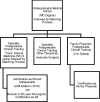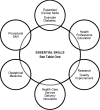The Evolution of General Internal Medicine (GIM)in Canada: International Implications
- PMID: 27778214
- PMCID: PMC5400753
- DOI: 10.1007/s11606-016-3891-z
The Evolution of General Internal Medicine (GIM)in Canada: International Implications
Abstract
General internal medicine (GIM), like other generalist specialties, has struggled to maintain its identity in the face of mounting sub-specialization over the past few decades. In Canada, the path to licensure for general internists has been through the completion of an extra year of training after three core years of internal medicine. Until very recently, the Royal College of Physicians and Surgeons of Canada (RCPSC) did not recognize GIM as a distinct entity. In response to a societal need to train generalist practitioners who could care for complex patients in an increasingly complex health care setting, the majority of universities across Canada voluntarily developed structured GIM training programs independent of RCPSC recognition. However, interest amongst trainees in GIM was declining, and the GIM workforce in Canada, like that in many other countries, was in danger of serious shortfalls. After much deliberation and consultation, in 2010, the RCPSC recognized GIM as a distinct subspecialty of internal medicine. Since this time, despite the challenges in the educational implementation of GIM as a distinct discipline, there has been a resurgence of interest in this field of medicine. This paper outlines the journey of the Canadian GIM to educational implementation as a distinct discipline, the impact on the discipline, and the implications for the international GIM community.
Keywords: Canada; Education; General internal medicine.
Conflict of interest statement
Funders
None.
Prior Presentations
Part of this article was presented at the Canadian Conference on Medical Education, 2014.
Conflict of Interest
The authors declare that they do not have a conflict of interest.
Figures


References
-
- Baillie H, Kenyon M. General internal medicine: A core specialty in jeopardy. BC Med J. 2005;47(7):377–8.
-
- Canadian Association of Interns and Residents. CAIR Position Statement on the Proposal to Recognize General Internal Medicine as a New Subspecialty. 2010.
-
- Canadian Society of Internal Medicine. Care-Fully: Defining a Plan for General Internal Medicine in Canada. 2005.
-
- Goldsand G, Thurber AD. The Overlapping Roles of Primary Care Physicians, General Specialists and Subspecialists - The Canadian Perspective. Presented at 7th International Medical Workforce Conference Oxford, United Kingdom. 2003.
Publication types
MeSH terms
LinkOut - more resources
Full Text Sources
Other Literature Sources
Miscellaneous

